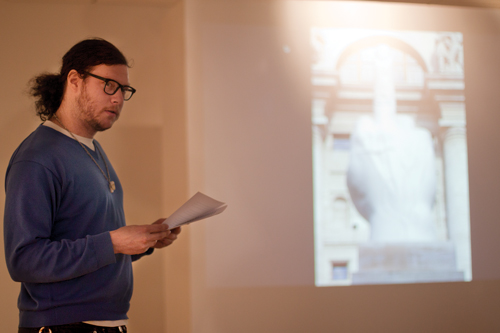When a multi-artist show titled Resolution(s) went up in Portland State’s Littman Gallery Thursday, Jan. 12, the show and its artists unintentionally triggered issues not uncommon in the art world: taboo subjects and the possibility of censorship.
Provocative art or hate speech?

When a multi-artist show titled Resolution(s) went up in Portland State’s Littman Gallery Thursday, Jan. 12, the show and its artists unintentionally triggered issues not uncommon in the art world: taboo subjects and the possibility of censorship.
The controversy involved a fortune cookie piece by anonymous art collective F* Mtn., titled “Xingùn Qiān B ng” (or “Fortune Cookie” in Chinese).
A cardboard box filled with 500 cellophane-wrapped fortune cookies sat in a corner of the gallery. When the cookies were cracked open, every single fortune read: “This cookie tastes bad and you’re a faggot.”
Several students who visited the gallery took some of the cookies to the Queer Resource Center, wanting to know why the cookies on display had such a hurtful statement tucked inside them.
On Wednesday, Jan. 18, “Fortune Cookie” was stolen from the gallery and found its way to the office of Dean of Student Life Michele Toppe, who judged the exhibit a “hate crime.” It was eventually retrieved from the QRC and returned to Littman, according to F* Mtn.’s artist statement.
As a response to these developments, the Littman and White galleries held a panel discussion Friday, Feb. 3, to discuss the piece and the place of derogatory speech in the art world.
Cassy Whitaker, administrative coordinator of the Littman and White Galleries—the two student-run art galleries on campus—began the discussion by focusing on the educational aspect of the galleries.
“We are here to think and talk about contemporary art,” Whitaker said.
J.P. Huckins, co-curator for the galleries and the sole curator for Resolution(s), showed other pieces from the exhibition as well as other artists’ works that have incited dispute in the contemporary art world.
The conversation, however, quickly refocused on “Fortune Cookie” and F* Mtn.’s use of a slur for homosexuals.
Cathlene McGraw, coordinator of the QRC, emphasized the emotional reactions of students that the exhibit provoked.
“Students were coming [to the QRC] with hurt hearts, wondering, ‘Why is this “Fortune Cookie” here?’” McGraw said.
One major complaint by several students present was the lack of context in F* Mtn.’s exhibit. Huckins noted that the artists’ bios were omitted and that the description of “Fortune Cookie” was hung away from the piece.
“Our intention has always been that the fortune cookies offer the view/participant a space for personal and private reflections on the absurd nature of the words inscribed on the fortune, of their definitions and connotations in that particular environment,” Ft. Mtn.’s artist statement reads. “We understand that a certain amount of responsibility falls on our shoulders to properly contextualize the work. We feel like we’ve done that.”
But others begged to differ.
“What were the artists’ reasons for using that word?” asked Diana Courvant, a student in attendance. “They proudly proclaim they put it into context. I don’t buy it.”
And while F* Mtn.’s statement clarifies that all members of the group identify as “queer,” this claim did nothing to satisfy students who demanded accountability.
“Just because you’re queer doesn’t mean you’re not accountable for your actions,” another student said.
Several students, including Courvant, observed that F* Mtn. chose not to attend the panel discussion. Although F* Mtn. wishes to remain anonymous as an artist collective, Courvant said that by doing so the group was “avoiding accountability.”
“They clearly don’t want to discuss it, or they would be here,” she said.
Huckins mentioned that there are many anonymous art collectives that have successfully remained anonymous and manage to maintain a strong message. Such groups as the Guerrilla Girls—a feminist art group that became famous in the late 1980s for their raw, often offensive issue-based art—are still a force in the art world today.
Horia Boboia, a PSU art instructor, listened to the issues that arose during the panel discussion and said that the focus should not be whether “Fortune Cookie” was good art, bad art or even art at all.
“I encourage my students to break borders,” Boboia said. “Let’s keep it about how this little gesture escalated to this level. It was a little joke, maybe a bad joke, but let’s keep that in perspective.”
A theater arts student then asked: “The question always is, ‘Is art for the sake of art okay?’”





